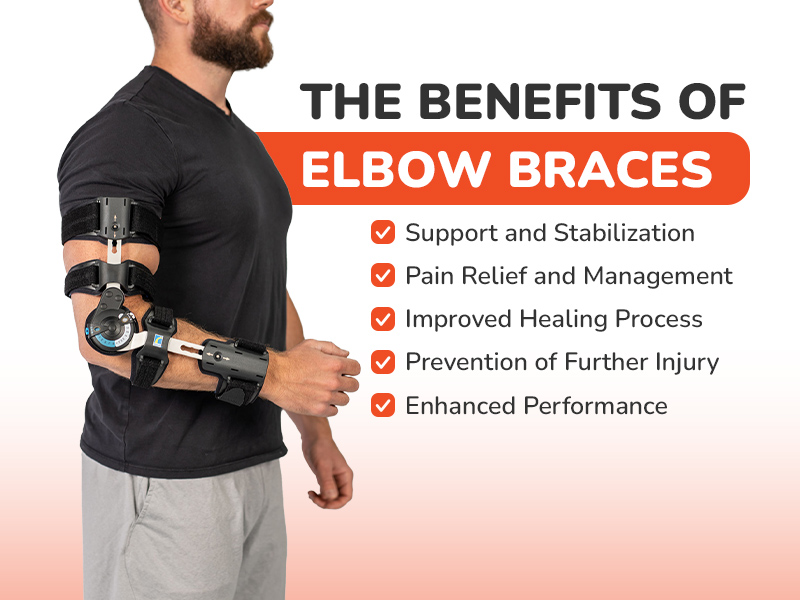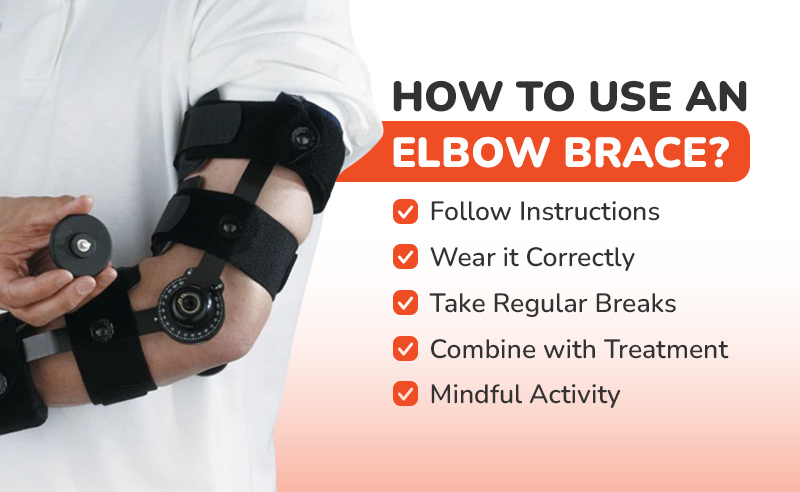Elbow Braces: Your Guide to Enhanced Recovery and Support
Elbow injuries can hinder everyday activities, whether you’re an athlete managing a strain or someone dealing with the aftermath of surgery. This is where elbow braces come into play—a versatile and essential aid that supports the injured area, mitigates pain and accelerates the healing process. But with a market flooded with many options, choosing the right elbow brace can be overwhelming. In this guide, we’ll walk you through the various aspects of elbow braces to help you make an informed decision for your health and comfort.
Understanding Elbow Braces
An elbow brace is more than just a piece of fabric; it’s a scientifically designed support system for one of your body’s most complex joints. The elbow joint is a synovial hinge joint that connects the upper arm to the forearm, enabling a range of motions such as flexion, extension, and rotation. When this joint is compromised due to an injury like a tennis elbow, golfer’s elbow, or sprain, an elbow brace provides a strategic advantage, offering support and limiting movement to promote healing.
The Benefits of Elbow Braces
Elbow braces serve not only as a tool for recovery but also as an aid in performance and daily activities. They offer multiple benefits, such as:

- Support and Stabilization: Elbow braces provide a supportive embrace to the elbow joint, minimizing excessive or harmful movements. This is especially crucial following an injury when the joint is vulnerable and recovering.
- Pain Relief and Management: The compression element of an elbow brace is instrumental in alleviating discomfort. It helps reduce inflammation, retains heat to improve circulation, and aids pain management.
- Improved Healing Process: By curtailing unwanted movement and providing a stable environment, elbow braces aid healing. The joint safeguarded against further injury, thus fostering a quicker and more effective recovery.
- Prevention of Further Injury: Elbow braces are indispensable for individuals engaging in sports or jobs with high strain on the elbow. They act as a preventative measure, keeping the elbow protected and less susceptible to future injuries.
- Enhanced Performance: For athletes, elbow braces can mean improved joint awareness and confidence during activity. This proprioceptive feedback can enhance performance by allowing for more controlled and powerful movements without the fear of injury.
Incorporating elbow braces into recovery routines or during physical activities can lead to a safer and more efficient path to rehabilitation and performance. They are protective gear and therapeutic aides contribute to overall elbow health and functionality.
Types of Elbow Braces
Elbow braces are crucial in managing various elbow-related conditions, offering benefits that range from basic support to complex stabilization. Here’s a breakdown of common types of elbow braces and their specific uses:
- Compression Sleeves: Typically made from stretchable, breathable materials, these sleeves offer snug support to ease pain, reduce swelling, and improve blood circulation. They are best for those dealing with minor strains or preventing elbow injuries during activities.
- Strap Braces: Featuring a focused pressure system, these braces are designed to alleviate stress on tendons, particularly beneficial for conditions like tennis or golfer’s elbow. The strap mechanism allows for adjustable compression, helping to reduce tendonitis pain and enable continued activity.
- Hinged Braces: For severe elbow injuries or post-surgical recovery, hinged braces restrict and control elbow movement to prevent further damage. Their structured design offers high protection and support, essential for proper healing.
- Sleeve with Strap Braces: Combining the benefits of compression and targeted pressure, these braces offer overall elbow support while applying specific pressure to alleviate tendon strain. This dual approach can be particularly effective for athletes requiring stability and flexibility.
- Adjustable Elbow Braces: These braces come with customizable features, such as removable splints or adjustable straps, to cater to a wide range of needs, from moderate support to firm stabilization. They are versatile and can be modified as the elbow heals or the wearer’s activity levels change.
Selecting the right elbow brace requires understanding the injury’s nature and the needed support level. With the correct brace, individuals can address current pain and discomfort and take proactive steps to prevent future elbow issues.
Read More: The Role of an Elbow Brace in Rehabilitation Following an Accident
Selecting the Right Elbow Brace
When choosing an elbow brace, finding one that fits well and meets your condition’s specific needs is important. Here’s a guide to help you select the right elbow brace:
- Understand Your Needs: Evaluate the severity and type of your elbow issue. A light compression sleeve might suffice for minor discomfort, while more serious conditions could necessitate a hinged or strap brace for additional support.
- Consult a Professional: It’s always wise to seek advice from a healthcare provider or a physiotherapist. They can diagnose your condition accurately and suggest the type of brace most beneficial for your recovery.
- Consider the Material: Comfort is key when wearing an elbow brace for long periods. Look for breathable and gentle materials on the skin to prevent irritation. Many modern braces come in moisture-wicking fabrics that keep the area dry and comfortable.
- Fit and Comfort: Ensure the brace fits snugly around your arm without cutting off circulation. The brace should stabilize the joint while still allowing for necessary movement. Adjustable straps can help achieve a custom fit.
- Activity Level Compatibility: Reflect on your daily activities and how the brace will accommodate them. If you’re an athlete or have a physically demanding job, you might need a brace that offers flexibility and support. Some braces are designed to fit seamlessly under clothing, making them suitable for continuous daily wear.
Remember, the right elbow brace should aid your healing process without causing additional issues. Take the time to try different options, and don’t hesitate to ask for a professional fitting to ensure the best results.
How to Use an Elbow Brace?
Getting the most out of your elbow brace means wearing and using it appropriately. Here are key points to follow:

- Follow Instructions: Read the manufacturer’s instructions for correctly wearing the brace.
- Wear it Correctly: The brace should fit comfortably, providing support without cutting off circulation. It should feel supportive but not uncomfortably tight.
- Take Regular Breaks: To maintain skin integrity and prevent irritation, remove the brace periodically throughout the day, especially if you notice any discomfort or moisture build-up.
- Combine with Treatment: Use the brace as part of a broader treatment plan, including rest, ice, compression, elevation (RICE), and physical therapy if needed.
- Mindful Activity: Be conscious of your activities while wearing the brace. Avoid movements that may strain the elbow further, even if the brace makes them less painful initially.
Adhering to these guidelines ensures that your elbow brace acts as a reliable ally in your healing process, providing the support you need while protecting the delicate structure of your elbow joint.
Caring for Your Elbow Brace
Taking good care of your elbow brace is important to extend its life and preserve its supportive features:
- Clean Regularly: Adhere to the cleaning instructions to prevent the buildup of sweat and bacteria. Some braces are machine-washable, while others may require hand-washing.
- Inspect for Wear: Regularly examine your brace for any signs of deterioration. Over time, fastenings can lose grip, and materials may stretch, reducing the brace’s effectiveness.
- Store Properly: When not in use, store your brace in a dry environment away from direct sunlight. Proper storage helps to maintain the shape and material of the brace.
- Avoid Unnecessary Stretching: Doing so gently to avoid overstretching the material when putting on or removing your brace.
- Follow Material-Specific Care: If your brace includes metal hinges or special materials, follow any additional care instructions to avoid rust or damage.
By using and caring for your elbow brace correctly, you can ensure it serves its purpose effectively, helping you on your journey to recovery.
Conclusion
An elbow brace is a crucial tool in recovering and managing elbow injuries. It offers support, enhances healing, and can even prevent future injuries. You can get the most out of this essential piece of supportive gear by understanding the different types of elbow braces available, how to choose and use them correctly, and how to care for them. Remember to consult with a healthcare professional for personalized advice, and never use a brace as a sole treatment method. With the right approach, an elbow brace can be your ally on the road to recovery and a return to your daily activities.



